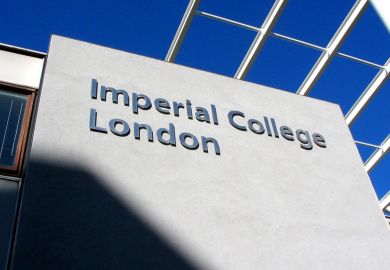What is the secret of a highly effective academic partnership?
Take the Israeli psychologists Daniel Kahneman and Amos Tversky. Although the latter died in 1996, it was their joint contribution to behavioural economics that landed Kahneman the 2002 Nobel Prize in Economics “for having integrated insights from psychological research into economic science, especially concerning human judgment and decision-making under uncertainty”, and that formed the basis for his celebrated 2011 book Thinking, Fast and Slow.
Theirs is also a rare example of an intellectual partnership that has been put under the microscope in a full-length book, Michael Lewis’ The Undoing Project: A True Story, published in 2016.
So what do we find? “We were quicker in understanding each other than in understanding ourselves,” Kahneman is quoted as saying. “We would finish each other’s sentences and frequently did. But we also kept surprising each other. It still gives me goosebumps.”
At one stage, according to Lewis, they were “spending six hours a day with each other, either holed up in a conference room or on long walks across Jerusalem…What they were like, in every way but sexually, was lovers. They connected with each other more deeply than either had connected with anyone else. Their wives noticed it [and] felt some jealousy.”
It is not difficult to find other researchers to speak about the pleasures of finding an academic “soulmate” and offer a vivid sense of why two heads are far better than one.
In 2002, Nicolas Gompel, chair of evolutionary ecology at LMU Munich, was working as a postdoctoral researcher at the University of Wisconsin-Madison. Glad to have got away from his native France, he was not particularly pleased when his boss told him that another Frenchman was joining the team.
Yet when he met his new lab mate, Benjamin Prud’homme, now a group leader in the Developmental Biology Institute of Marseilles, something “clicked” and “very quickly turned into intense and productive scientific discussions”. Gompel puts this down to a number of factors: “First and foremost, Benjamin and I were driven by very similar scientific interests. This has been the glue of our relationship from the start. But there is more…[We] start from a scientific observation. It prompts new questions. One of us comes up with a plan to scientifically address the question. The other plays devil’s advocate, challenges and demolishes the new plan.
“It could end there, but we give the game a more interesting twist: we build from the ruins and try to come up with a modified and stronger experimental plan. This goes on for a few rounds until we have mentally explored every corner of the problem and have agreed on a worthwhile, solid plan.”
In 2007, after rapidly publishing two joint papers in Nature, Gompel and Prud’homme started a research group in Marseilles and worked together for seven years, until the former moved to Germany. “The same academic community which was initially so cautious about a bicephalous research group soon identified us as a scientific couple, and – ironically – treated my move to a solo career as a divorce!” he reflects. “The truth is that it was certainly not a divorce…The essence of our collaboration is intact.”
At its heart has been not only “mutual trust and respect” but “the ability to put our egos aside”, since “this was never a pissing contest, but rather a genuine effort to join forces to solve something. As a result, we have never fought, never argued about authorship or ownership of ideas.”
Long-term partnerships in biomedical science are “not rare”, according to William Cookson, professor of genomic medicine at Imperial College London. “But equal partnerships occur far less commonly. We were, for example, the first recipients of a Wellcome Trust Joint Senior Investigator Award.”
He is speaking about his collaboration with Miriam Moffatt, professor of respiratory genetics at Imperial, which has now been going for close to 30 years since they first “joined forces to carry out progressively bigger international studies of the genetics of asthma”.
Today, they “work closely together on all our projects, sharing a single large office”. But they are certainly no strangers to crossed swords: “We do not always agree with each other, and have frequent lively debates about the way forward that amuse our team…In general, I’m always pushing to start new projects, and Miriam is pushing to make sure the existing projects are completed and published to the highest standards before we take on too many further projects. We encourage our group to take part in these discussions (and to tell me to eff off if I deserve it!).”
But in Cookson’s view, “the man-woman dynamic” generally serves to diffuse “the inevitable tensions of running a complex research programme. If we were both men, there would be a lot more testosterone and dominance behaviours, and decision-making would be much less rational (and more wearisome).”
Long-term partnerships are perhaps less common in the humanities, where research remains, in general, a solitary endeavour. However, there are exceptions. The philosophers Stephen Mumford and Rani Lill Anjum – another male-female partnership – have collaborated since 2007, producing four books and more than 30 papers. They have also written an article for Times Higher Education about the advantages of joint authorship (“Confronting the suspicion (and misconceptions) of co-authorship”, 16 December 2015).
Anjum, now a research fellow at the Norwegian University of Life Sciences, argues that such collaboration is “more fun, more inspiring, better for me and better for those who join in”. It also has clear intellectual benefits, provided that the inevitable tensions can be embraced and worked through.
“I would not be able to challenge my own ideas in the way that Stephen does, since I, of course, agree completely with myself,” she reflects. “Sometimes it turns out that what one of us thinks is a minor change in a phrase is actually a source of major disagreement. When these disagreements are made explicit and we argue through them (sometimes over a long time and with a lot of drama and heated discussion), the result is often that we have both learned something new, or developed our ideas even further…Two people can challenge one another and bring a text forward in a way that one does not get with mere peer review.”
Other scholars suggest that the intellectual stimulus and emotional support of working with a partner can be crucial, particularly in carving out new intellectual terrain.
When Imelda Whelehan, dean for higher degree research at the Australian National University, got her first academic post at De Montfort University, her interests focused on “feminist criticism, women’s writing and popular culture”. Yet she was given a month to prepare a course on Shakespeare and decided to teach “Shakespeare on screen”. She was soon joined at De Montfort by Deborah Cartmell (now professor of English there), who had a background in Renaissance literature, and they launched into a programme of joint teaching, during which, according to Cartmell, “we were able to feed off and challenge each other. After almost every session, we would say, ‘We should really publish that.’ And we did.”
Over the ensuing 20 years, their collaboration helped to forge the fledgling field of adaptation studies. They co-authored the 2010 book Screen Adaptation: Impure Cinema, co‑edited three more (including The Cambridge Companion to Literature on Screen) and are still the editors of the journal Adaptation.
“This was the period of the quality BBC TV adaptation [of classic 19th-century novels],” recalls Whelehan. “People were using these works in the classroom, but the critical perspectives…were underdeveloped. The conjoining of our interests and strengths meant that we produced work that I don’t think would have emerged [separately]…We seem to be able to co-write to the point where I forget where I end and she begins…People who don’t know us confuse our names.”
But such intermingling has its limits: “A low point of our partnership was being asked to do a keynote together and being offered a shared hotel room!” Whelehan recalls.
Meanwhile, from 1997 to 2007, Heidi Macpherson and William Kaufman played a key role in nurturing another emergent field. When they were based at the University of Central Lancashire, the institution formed part of the consortium that set up the Maastricht Centre for Transatlantic Studies. They both joined the board of directors, taught together, organised two pioneering conferences and edited two collections and a three-volume encyclopedia, Britain and the Americas: Culture, Politics, and History. Somebody once referred to them as “the Simon and Garfunkel of transatlantic studies”.
Macpherson – now president of the College at Brockport, a liberal arts college that is part of the State University of New York – stresses how they were able to pool a “wider range of knowledge”, since she brought to the collaboration “a feminist literary perspective”, while Kaufman came from “a more historical and cultural studies perspective”.
Kaufman himself, professor of American literature and culture at Uclan, felt “part of a project that was only then opening up and defining itself, so things seemed fluid and flexible. There was a sense of ‘Anything goes, so let’s try this. After all, no one’s life will depend on it.’ ”

The joy of marching together: collaboration is ‘more fun, more inspiring, better for me and better for those who join in’
Another example of a partnership in economics is that of Andrew Oswald, professor of economics and behavioural science at the University of Warwick, and David (“Danny”) Blanchflower, professor of economics at Dartmouth College. Over four decades, the pair have pioneered both the study of huge datasets and the statistical analysis of happiness.
As well as complementary intellectual skills (“Danny’s a data genius!”), Oswald flags up the value of mutual support in coping with setbacks: although they found it difficult to publish an early and now much-cited paper on happiness, “we were pretty sure we were right. It would have been harder as a singleton. When the paper got rejected, one of us would say to the other: ‘You know, we’re right and those people are wrong.’ ”
In addition to his work with Blanchflower, Oswald has written a few papers with his wife, Amanda Goodall, a senior lecturer at City, University of London’s Cass Business School. However, he notes that “working with a spouse is much more complicated. I don’t have to tuck Danny Blanchflower into bed at night! That’s a big help. A spouse is part of your whole life.”
Although there is clearly much to be celebrated in these stories, many of those involved in long-term intellectual partnerships also point to crucial challenges. Some of these relate to the fact that academic structures of prestige and career-building are implicitly designed for individuals rather than duos.
“You have to have an agreed outcome, and some wiggle room around time frames,” suggests Whelehan. Problems can arise when a project crucial for one person’s career is “just an added luxury for the other”.
Cartmell adds that when they both worked at De Montfort, “only one of us could use a joint publication for research reviews…I suspect that if we did nothing else but collaborated with each other, there would be questions asked about whether we were equal partners, whether we were capable of working independently and whether we ‘needed’ each other in order to be a ‘whole’ researcher.”
Imperial’s Cookson remembers how he and Moffatt initially “had to fight the perception that Miriam (a younger woman) was not an equal in the partnership”, as well as speculations about whether they were romantically involved, “which is flattering for me but demeaning for Miriam, and potentially uncomfortable for our spouses. In fact, it is another way of belittling women’s contribution to a shared enterprise.”
Mumford and Anjum paint perhaps the most sobering picture. Although they have established a social media “brand” under the name “Team MumJum”, Anjum suffered when a promotion committee “argued that my contribution to the work was not established sufficiently. This has made it difficult for me to enjoy collaborations in the same way that I used to. Now I always have to ask myself: is it worth it? Should I do this solo?” Mumford, professor of metaphysics at Durham University, adds that, for women, the perils of collaboration may be even greater, citing a 2017 study of US tenure applications that suggested that when a man and woman write together, the man tends to get 80 per of the credit. In their case, “we had to think quite hard about ways to counter this effect, including a statement that we took equal credit. But I would still totally understand if Rani chose women co-authors for future collaborations.”
Whatever genders are involved, few academic marriages last forever. Even Kahneman and Tversky eventually went their separate ways, their intellectual ardour cooled by fame, geographical distance and Kahneman’s sense that he was not receiving sufficient credit for their joint work. Indeed, there came a point when he simply walked out, and the pair might never have spoken again, if Tversky hadn’t called him three days later to say that he had been diagnosed with terminal cancer.
One of the reviewers of Michael Lewis’ book about the relationship wrote that its closing pages left her “blinking back tears”. We can only speculate about how great a loss we have to mourn as a result of the structural and gender-related factors that make such intellectual synergy troublesome to pursue. However, universities might be well advised to reflect on that question.






